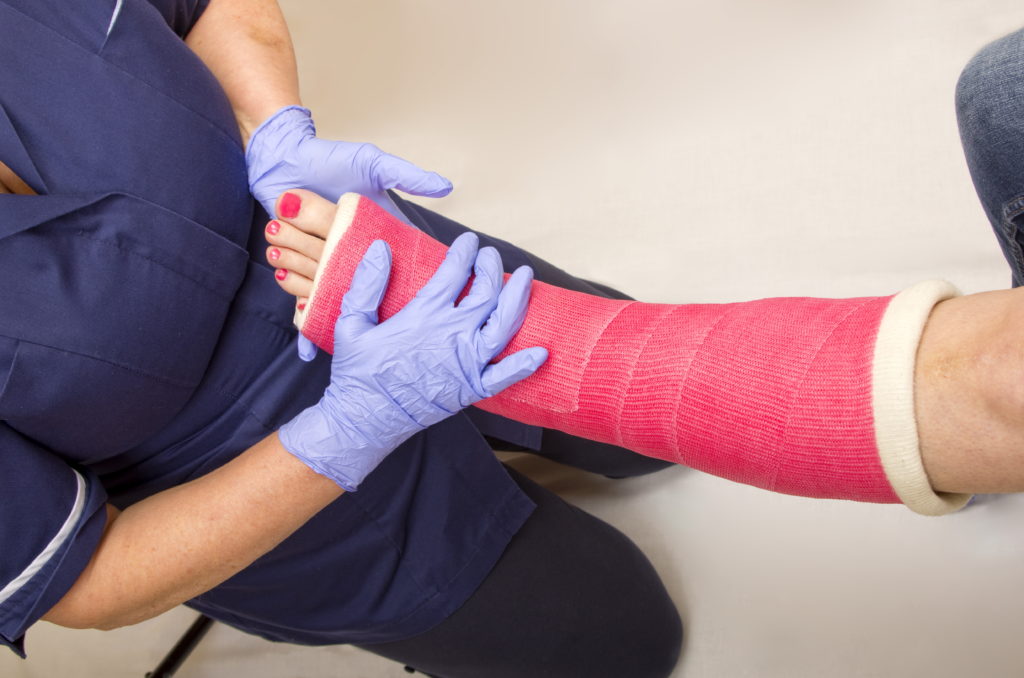What is Ankle Fracture?

Ankle fracture refers to a condition in which one or more bones in the ankle break. There are three bones in the ankle, the tibia, the fibula, and the talus. Ankle fractures vary depending on the fracture and extent of force that caused the fracture. It can range from a tiny crack in the bone to a serious break where the skin is pierced by the bone.
What causes an Ankle Fracture?
There are several common causes and risk factors that can lead to an ankle fracture. For example, a trip or fall on a hard surface can cause direct trauma to the ankle. Similarly, landing from a forceful jump, a car accident, high impact sports like football, soccer, basketball, tennis, or even gymnastics. Any type of incorrect technique or sports training or even the lack of strength training can lead to an ankle fracture. Wearing improper or ill-fitting shoes or putting down your foot awkwardly can result in a twist or roll and break. Osteoporosis can aggravate the risk of ankle fracture.
What are the signs and symptoms of an Ankle Fracture?
Severe pain and inability to bear weight or immediate swelling are signs and symptoms of an ankle fracture. The bruised bone may stick out of the skin and cause bleeding. Usually, X-ray images are done to confirm whether an ankle fracture has taken place and the foot appears to be dislocated or crooked. It also shows the exact location of the fracture, the type, and the seriousness of the ankle fracture. If required, a CT scan or MRI may have to be taken. An ankle sprain occurs when the tendons are torn, but the bones are not broken.
Are you worried about the symptoms of an ankle fracture? Consult a physiotherapist and book your assessment at 3630 Lawrence Ave E, Scarborough, ON M1G 1P6 or 200 Marycroft Ave, Unit #6, Woodbridge, ON, L4L 5X9 right away.
How is an Ankle Fracture treated?
The ankle bone fracture and its seriousness determine the treatment. However, physiotherapy is required to assist in the recovery of the ankle joint after it has healed, irrespective of the treatment. If the ankle fracture is mild, the treatment includes a splint, cast, or a walking boot, which helps to keep the bone in position during healing. To assist with mobility and without bearing the weight on the ankle, crutches are provided. If the bone or bones have moved out of place, reduction, a non-surgical process, is performed to physically bring two ends of the fracture back into alignment.
Severe ankle fractures that do not heal with a splint, cast, or boot require surgery. It may be necessary to implant rods, plates, pins, or screws to fuse the bones together. After the surgery, a cast, splint, or boot may be required. An ankle fracture requires a cast that is usually kept for a period of five to eight weeks. After the cast is removed, physiotherapy is recommended to restore normal range of motion, gait, and overall muscle tone and strength.
This will also restore the surrounding muscles and ligaments which might have become stiff and weak with the cast. Irrespective of the type and severity of the fracture, ankle fractures take time to heal and recover. The physiotherapist can help you regain stability and steady recovery.
Rehabilitation physiotherapy is a non-surgical and drug-free treatment. It focuses on reducing swelling and pain, regaining strength, and improving joint function and mobility. It also helps prevent a recurrence.
Physiotherapy is based on individual needs and includes activity modifications and functional retraining. This may include a walking aid, initially, followed by strengthening and stretching exercises for the knee and hip. It also includes a range of motion, flexibility exercises, and balance and control exercises.
A personalized exercise plan is provided to carry out at home and improve and make progress continuously. Preventive strategies are in place to enable you to manage your work, lifestyle, work, and other risk factors. Others include patient education, return to work, or sport recommendations.
Other therapies include cross-disciplinary pain-relieving therapies, like Heat and cold therapy, Manual therapy to minimize scar tissue, Ultrasound therapy (if there are no surgical screws or pins), Acupuncture, Interferential current therapy (IFC).
At our clinic we have notice by using Simply Align Technique which includes advance physical modalities, activity modification and specific exercises we have faster, longer lasting results with reduced healing time. We can use Elector-Magnetic Therapy while you feet is in the cast for faster healing.
Can an Ankle Fracture go away?
No, it cannot go away on its own. Whether it is minor or major, an ankle break will require a cast, splint, or a walking boot. After the cast is removed, you will need physiotherapy, followed by rehab. Physiotherapy for a post-ankle fracture usually takes about 12 to 18 weeks. This will have to be supplemented with a healthy diet to facilitate a speedy recovery. Smoking must be avoided at all costs as it disrupts the body’s ability to create new bone tissue and slows bone healing.
Can an Ankle Fracture be prevented?
Yes, ankle fractures can be prevented by including strengthening and stretching exercises in one’s overall fitness plan. If you play sports, you need to find out from a physiotherapist about the best exercises for your activities. Few important steps to be kept in mind are: Warming up and stretching before exercise, cooling down and stretching after exercise, and practicing appropriate techniques in sport. For example, wearing the appropriate shoes for an activity or wearing orthotics, maintaining a healthy weight, and eating foods rich in calcium to build bone strength. Also when starting a new exercise or fitness program one needs to begin slowly and gradually increase the training. Stress fractures can also be prevented through cross-training, such as alternating between running, cycling, and swimming.








